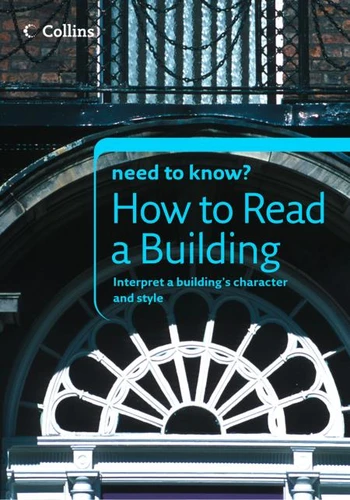How to Read a Building
Par :Formats :
Disponible dans votre compte client Decitre ou Furet du Nord dès validation de votre commande. Le format ePub protégé est :
- Compatible avec une lecture sur My Vivlio (smartphone, tablette, ordinateur)
- Compatible avec une lecture sur liseuses Vivlio
- Pour les liseuses autres que Vivlio, vous devez utiliser le logiciel Adobe Digital Edition. Non compatible avec la lecture sur les liseuses Kindle, Remarkable et Sony
- Non compatible avec un achat hors France métropolitaine
 , qui est-ce ?
, qui est-ce ?Notre partenaire de plateforme de lecture numérique où vous retrouverez l'ensemble de vos ebooks gratuitement
Pour en savoir plus sur nos ebooks, consultez notre aide en ligne ici
- Nombre de pages192
- FormatePub
- ISBN978-0-00-756347-0
- EAN9780007563470
- Date de parution22/05/2014
- Protection num.Adobe DRM
- Infos supplémentairesepub
- ÉditeurCollins
Résumé
Architecture is all around us - it is part of our lives, and its development is a central theme in the history of mankind. Learning to read a building is the route to understanding a major part of our cultural inheritance.
Collins Need to Know? How to Read a Building shows you how to analyse and interpret architectural features with confidence.
Have you ever wanted to be able to tell the difference between tudor and mock-tudor? Want to learn what components make a building gothic? Ever wondered what has influenced how our towns and cities were built? Want to understand the major traditions of architecture?
Collins Need to Know? How to Read a Building takes the reader through the process of learning more about the built environment.
Starting with the basics of analysing the home, then moving onto looking at public buildings and larger and more well-known structures, Timothy Brittain-Catlin shows the reader how features are inherited and copied, as well as adapted with each new generation. Whether you live in a small flat or detached house, you can find traces of architectural history - and learn to interpret the features you see and put them into the wider context of your surroundings.
This book will help you start to uncover fascinating aspects of architectural style and history from the buildings you pass every day. Contents:Introduction: Architecture is for everyoneChapter 1: The elements of architectureChapter 2: The Classical traditionChapter 3: The Gothic traditionChapter 4: The Nineteenth centuryChapter 5: Architecture since 1900Chapter 6: Thinking Architecturally Also contains comprehensive glossary of terms and quick reference ID guides.
Starting with the basics of analysing the home, then moving onto looking at public buildings and larger and more well-known structures, Timothy Brittain-Catlin shows the reader how features are inherited and copied, as well as adapted with each new generation. Whether you live in a small flat or detached house, you can find traces of architectural history - and learn to interpret the features you see and put them into the wider context of your surroundings.
This book will help you start to uncover fascinating aspects of architectural style and history from the buildings you pass every day. Contents:Introduction: Architecture is for everyoneChapter 1: The elements of architectureChapter 2: The Classical traditionChapter 3: The Gothic traditionChapter 4: The Nineteenth centuryChapter 5: Architecture since 1900Chapter 6: Thinking Architecturally Also contains comprehensive glossary of terms and quick reference ID guides.
Architecture is all around us - it is part of our lives, and its development is a central theme in the history of mankind. Learning to read a building is the route to understanding a major part of our cultural inheritance.
Collins Need to Know? How to Read a Building shows you how to analyse and interpret architectural features with confidence.
Have you ever wanted to be able to tell the difference between tudor and mock-tudor? Want to learn what components make a building gothic? Ever wondered what has influenced how our towns and cities were built? Want to understand the major traditions of architecture?
Collins Need to Know? How to Read a Building takes the reader through the process of learning more about the built environment.
Starting with the basics of analysing the home, then moving onto looking at public buildings and larger and more well-known structures, Timothy Brittain-Catlin shows the reader how features are inherited and copied, as well as adapted with each new generation. Whether you live in a small flat or detached house, you can find traces of architectural history - and learn to interpret the features you see and put them into the wider context of your surroundings.
This book will help you start to uncover fascinating aspects of architectural style and history from the buildings you pass every day. Contents:Introduction: Architecture is for everyoneChapter 1: The elements of architectureChapter 2: The Classical traditionChapter 3: The Gothic traditionChapter 4: The Nineteenth centuryChapter 5: Architecture since 1900Chapter 6: Thinking Architecturally Also contains comprehensive glossary of terms and quick reference ID guides.
Starting with the basics of analysing the home, then moving onto looking at public buildings and larger and more well-known structures, Timothy Brittain-Catlin shows the reader how features are inherited and copied, as well as adapted with each new generation. Whether you live in a small flat or detached house, you can find traces of architectural history - and learn to interpret the features you see and put them into the wider context of your surroundings.
This book will help you start to uncover fascinating aspects of architectural style and history from the buildings you pass every day. Contents:Introduction: Architecture is for everyoneChapter 1: The elements of architectureChapter 2: The Classical traditionChapter 3: The Gothic traditionChapter 4: The Nineteenth centuryChapter 5: Architecture since 1900Chapter 6: Thinking Architecturally Also contains comprehensive glossary of terms and quick reference ID guides.



